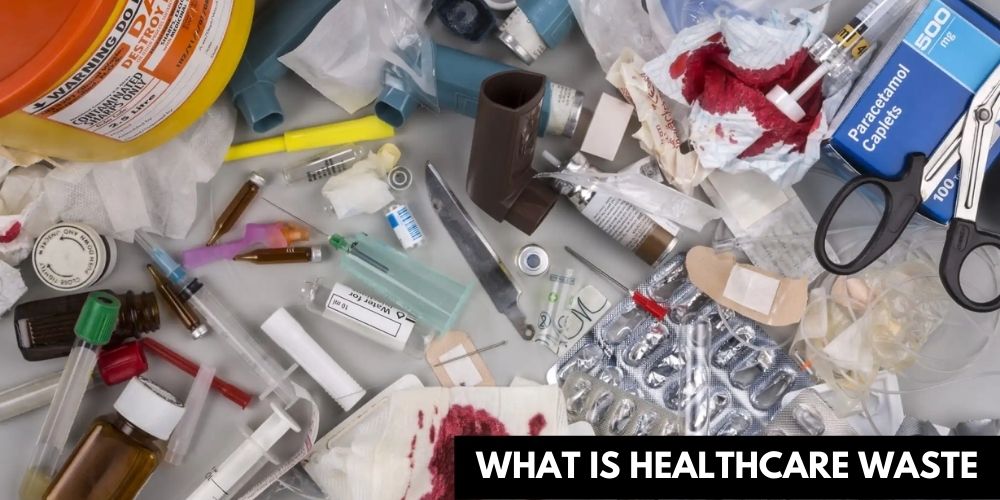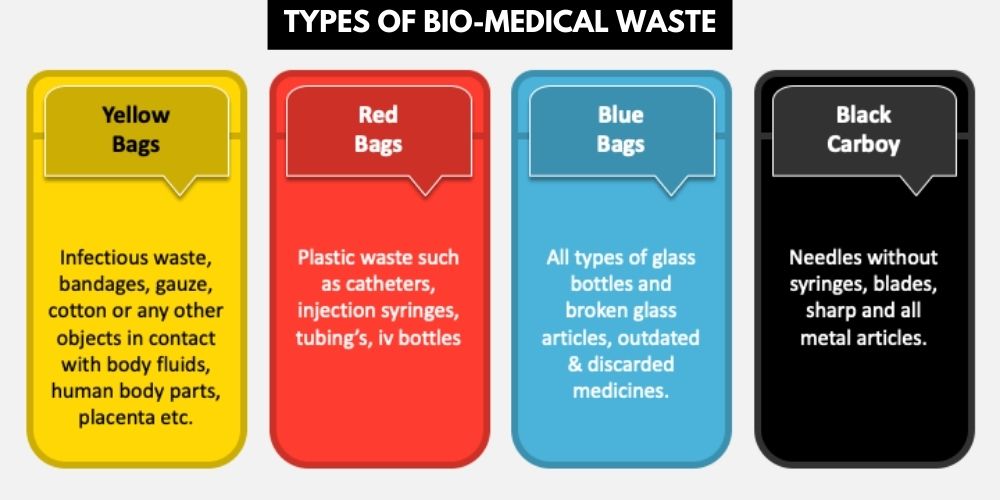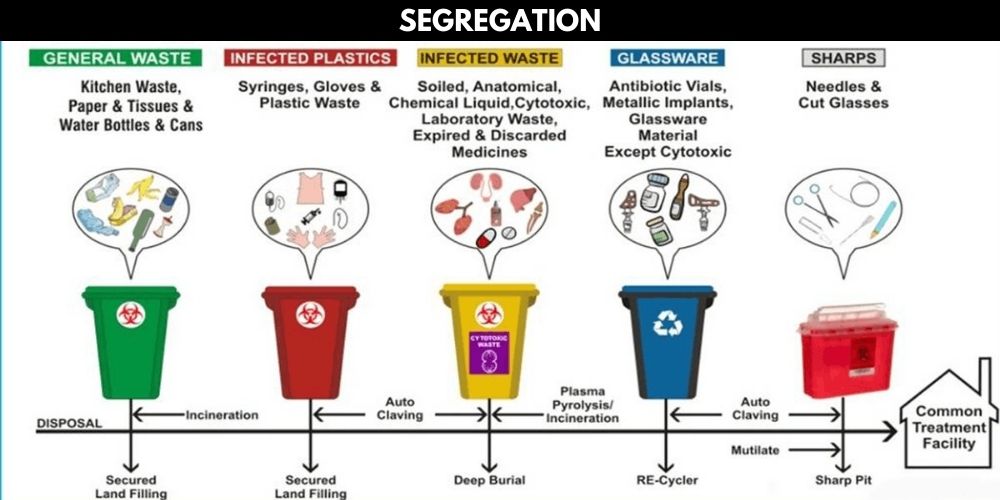
Segregation of healthcare or medical waste
Posted on 02-10-2022 05:08:37
All human activities produce waste. We all recognize that such waste can be dangerous and desires safe disposal. Industrial waste, sewage, and agricultural waste pollute water, soil, and air. It can also be dangerous to humans and their surroundings. Similarly, hospitals and other fitness care centers generate plenty of waste that can transmit infections, specifically HIV, Hepatitis B & C, and Tetanus, to the people who manage it or are available in contact with it.
India generates around three million tonnes of scientific waste each year and the quantity is anticipated to grow at 8 percent annually.
What is Healthcare Waste

Healthcare Wastes get up from human and animal healthcare, i.E. From hospitals, GP surgical procedures, dental surgeries, veterinary surgical procedures, and many others., and have diagnosed EWC codes. Segregating your waste into suitable color-coded containers is good to waste control and also will help you to conform together with your legal necessities. By segregating your waste nicely, you can shop cash on waste disposal.
Types of Bio-medical waste

The Bio-scientific waste way “any strong and/or liquid waste consisting of its field and any intermediate product, that’s generated during the prognosis, treatment or immunization of people or animals or research activities pertaining thereto or within the manufacturing or testing of organic or in fitness camps.
Biomedical waste poses a hazard due to two principal reasons – the first is infectivity and other toxicity.
The bio-Medical waste consists of
1-Human anatomical waste like tissues, organs, and body parts
2-Animal wastes generated during research from veterinary hospitals
3-Microbiology and biotechnology wastes
4-Waste sharps like hypodermic needles, syringes, scalpels, and broken glass
5-Discarded medicines and cytotoxic drugs
6-Soiled waste such as dressing, bandages, plaster casts, material contaminated with blood, tubes, and catheters
7-Liquid waste from any of the infected areas
8-Incineration ash and other chemical wastes
Segregation

Segregation refers to the fundamental separation of various categories of waste generated at the supply and thereby lowering the risks in addition to the value of coping with and disposal. Segregation is the most crucial step in bio-medical waste management. Effective segregation on my own can ensure effective biomedical waste management.
1-Segregation reduces the amount of waste that wishes unique dealing with and remedy
2-Effective segregation technique prevents the aggregate of clinical waste like sharps with the general municipal waste.
3-Prevents illegally reusing certain additives of clinical waste like used syringes, needles, and other plastics.
4-Provides a possibility for recycling sure components of clinical waste like plastics after right and thorough disinfection.
How does segregation help?
1-Recycled plastic material may be used for non-food grade applications.
2-Of the general waste, the biodegradable waste can be composted inside the health facility premises and may be used for gardening functions.
3-Recycling is a superb environmental practice, which can also double as a sales-generating pastime.
4-Reduces the value of remedy and disposal (eighty according to cent of a sanatorium’s waste is trendy waste, which does not require special remedy, supplied it is not infected with different infectious waste).
Collection
The collection of biomedical waste involves the use of different styles of boxes from numerous assets of biomedical wastes like Operation Theatre, laboratory, wards, kitchen, corridor, and many others. The bins/ packing containers ought to be located in any such way that a hundred% collection is achieved. Sharps need to continually be saved in puncture-evidence boxes to keep away from accidents and infection to the people dealing with them.
Once series happens then the biomedical waste is saved in the right area. Segregated wastes of different categories want to be gathered in identifiable boxes. The length of storage needs to now not exceed 8-10 hrs in huge
hospitals (greater than 250 bedded) and 24 hrs in nursing homes. Each field can be sincerely classified to reveal the ward or room wherein its miles are saved. The purpose of this labeling is that it may be vital to hint the waste lower back to its source. Besides this, the storage area should be marked with a caution signal.
Transportation
The waste needs to be transported for remedy either in trolleys or in a protected wheelbarrow. Manual loading should be averted as a way feasible. The bags / Container containing BMWs have to be tied/ lidded before
transportation. Before transporting the bag containing BMWs, it needs to be followed with the aid of a signed document by way of the Nurse/ Doctor mentioning the date, shift, quantity, and destination.
Special automobiles need to be used if you want to prevent access to, and direct contact with, the waste by way of the transport operators, the scavengers, and the general public. The transport bins ought to be nicely
enclosed. The effects of visitors’ injuries need to be considered inside the design, and the driving force ought to learn within the processes he has to observe in case of accidental spillage. It has to also be viable to scrub the interior of the packing containers very well.
Personnel safety devices
The use of protective gears should be made mandatory for all the personnel handling waste.
Gloves: Heavy-duty rubber gloves have to be used for waste management with the aid of waste retrievers. This has to be shiny yellow in color. After dealing with the waste, the gloves ought to be washed twice. The gloves have to be washed after every use with carbolic soap and a disinfectant. The size must match the operator.
Aprons, gowns, fit, or another garb: Apparel is worn to save you contamination of clothing and protect the pores and skin. It will be the product of fabric or impermeable material such as plastic. People working in incinerator chambers need to have gowns or fits manufactured from non-inflammable material.
Masks: Various varieties of masks, goggles, and face shields are worn by myself or in aggregate, to offer a shielding barrier. It is obligatory for personnel operating in the incinerator chamber to wear masks overlaying
each nostril and mouth, preferably a gas mask with filters.
Boots: Leg coverings, boots, or shoe covers offer more protection to the skin while splashes or huge portions of inflamed waste ought to be dealt with. The boots need to be rubber-soled and anti-skid kind. They must cowl the leg as much as the ankle.
Cleaning devices
Brooms: The broom shall be no less than 1.2 m lengthy, such that the worker wants not to stoop to comb. The diameter of the broom should be handy to address. The brush of the broom will be tender or hard depending on the kind of floor.
Dustpans: The dustpans must be used to accumulate the dust from the sweeping operations. They can be both of plastic or enameled steel. They have to be free of ribs and ought to have clean contours, to prevent dust from
sticking to the floor. They have to be washed with disinfectants and dried before each use.
Mops: Mops with lengthy handles should be used for swabbing the ground. They shall be of either the fabric or the rubber variety. The mop has to be replaced relying on the damage and tear. The mechanical-screw kind of mop
is handy for squeezing out the water.
Vacuum cleaners: Domestic vacuum cleaners or commercial vacuum cleaners can be used depending on the dimensions of the rooms.
Storage devices
Dustbins:
It may be very essential to assess the amount of waste generated at every factor. Dustbins must be of such potential that they do now not overflow among each cycle of waste series. Dustbins ought to be cleaned after each cycle of clearance of waste with disinfectants. Dustbins can be covered with plastic luggage, which can be chlorine-unfastened, and coloration-coded as per the law.
Trolleys
The use of trolleys will facilitate the elimination of infectious waste at the supply itself, in preference to including managing devices a brand new category of waste.
Wheelbarrows:
Wheelbarrows are used to transfer the waste from the factor source to the gathering facilities. There are two kinds of wheelbarrows – blanketed and open. Wheelbarrows are fabricated from steel and supplied with two wheels and a take care of. Care should be taken no longer to at once dump waste into it. Only packed waste (in plastic baggage) must be carried. Care need to also be taken no longer to allow liquid waste from spilling into the wheelbarrow because it will corrode. These are ideal for transferring debris within the institution. Wheelbarrows additionally come in diverse sizes relying on the software.
Chutes:
ChutesChutes are vertical conduits furnished for easy transportation of refuse vertically within the case of institutions with greater than two floorings. Chutes ought to be made of stainless steel. It should have a self-last lid. These chutes must be fumigated every day with formaldehyde vapors. The contaminated linen(contaminated with blood and or other body fluids) from every floor has to be bundled in soiled linen or in plastic baggage before ejecting into the chute.
Alternately, elevators with mechanical winches or electrical winches can be supplied to bring down waste packing containers from every floor. Chutes are necessary to avoid horizontal shipping of waste thereby minimizing the routing of the waste inside the premises and for this reason lowering the threat of secondary infection.